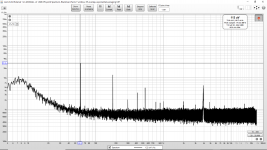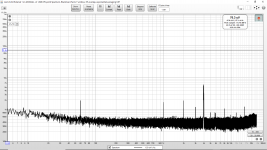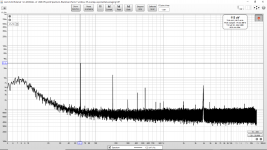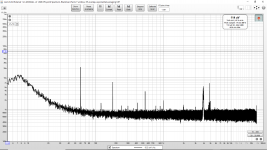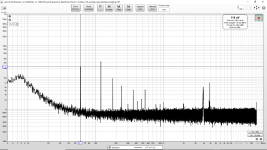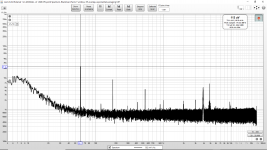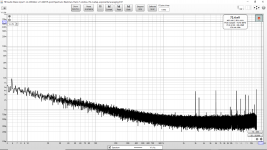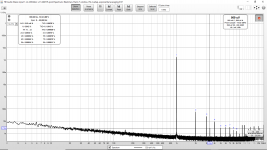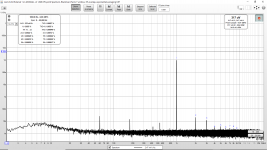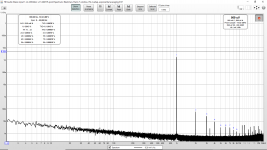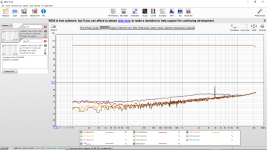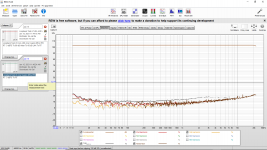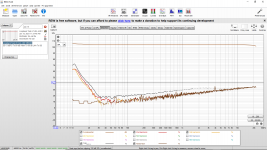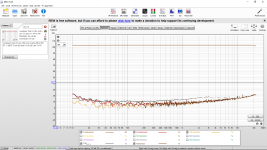kozard,
Given the problems so far, you might try teasing out the source of the spurs with some experiments. For example just try shorting out the input of the cable from the LNA going to interface. Leave the cable in still routed as it would be if trying to measure the LNA. Or, perhaps try measuring the LNA noise with its power disconnected. In other words, start breaking down the problem into smaller areas to focus on.
Also, you could try taking a source of magnetic interference (I use an old Radio Shack tape head demagnetizer), turn it on and bring it towards the LNA. Do you find any sensitivity to noise source with the shielding in place? Can you probe out the weakest part of the experimental setup?
Hopefully, you get the idea. Start troubleshooting the apparatus for clues.
Given the problems so far, you might try teasing out the source of the spurs with some experiments. For example just try shorting out the input of the cable from the LNA going to interface. Leave the cable in still routed as it would be if trying to measure the LNA. Or, perhaps try measuring the LNA noise with its power disconnected. In other words, start breaking down the problem into smaller areas to focus on.
Also, you could try taking a source of magnetic interference (I use an old Radio Shack tape head demagnetizer), turn it on and bring it towards the LNA. Do you find any sensitivity to noise source with the shielding in place? Can you probe out the weakest part of the experimental setup?
Hopefully, you get the idea. Start troubleshooting the apparatus for clues.
Last edited:
Just buy a Topping D50s for $250 and be instantly done with it. It is exceptional at the money and does everything you would want.
I totally second this. The Topping D50 is amazing if it cost $1500 let alone $250. This is a no risk issue. There is no way you will not love it.
.....
Since it is 60 Hz (and 180 Hz) is it correct to conclude this is not from the power supply? ....
and what kind of EMI filter is before the transformer?
Ok. I did the following:
I made measurements with the ground connected to the outer (first attached), inner (second) and neither (third). The 60 Hz hardly moved at all. The fourth is a measurement with the LNA powered down showing the components that are likely from my 24 bit USB Sound Blaster Live. (I would love to get rid of the 4kHz spike which I believe is something inside the USB interface. I wonder if anyone has modified/improved one of these Creative SB0490.)
- Placed the LNA in a first (internal) steel box but make no electrical connections to this first steel box. [Royal Dansk Cookie Tin 😀]
- Placed the first steel box inside a second larger box. [Heavy Stainless Cooking Pot]
- Connected the larger (outside) steel box to ground.
- Connected the LNA ground to the larger (outside) steel box.
During the measurements I unplugged everything in the area including the overhead workshop light. The laptop was running on batteries.
Since it is 60 Hz (and 180 Hz) is it correct to conclude this is not from the power supply? There is no 120 Hz. (No sign of 120 Hz at all, so this is likely a clue.) I am not sure what to look for next.
The shielding experiment seemingly yielded nothing. Prior to the shielding experiment I greatly increased critical power supply caps 10x in size and ultra low ESR (should be totally unnecessary) and the 60/180 Hz did not move. (I already assumed it was not the power supply but I wanted to be 100% sure.)
Again the LNA has LM317/LM337 onboard with denoiser, plus CRC filter before those and then the rejection of the NE5534. (TL071 used as DC offset servo.) Again it is a Douglas Self MC type LNA.
Before the LNA board and external to the shielding is a second LM317/LM337 board that preregulates to +/- 20VDC. That board has nice large low ESR capacitors on input and Vadj.
Not sure what to try next. I might try swapping for high rejection ratio operational amplifiers. (I have some OPA228 and OPA277.)
Or maybe I try a different interface. Could the 60 Hz and 180 Hz possibly come from the LNA output connection to the 24 bit USB Sound Blaster Live? I would think not since the loopback is cleaner, the connection is shielded and the laptop is running on batteries.
It would be a pain but maybe I should try to run on batteries for a last test to totally rule out the input power to the LNA. Maybe I use two stacks of three 9V for a quick test.
Or perhaps I should try using a different audio interface?
Or maybe these levels are as good as it is going to get for now? The screen shots show the noise on the output of the LNA on the 60 dB gain setting. So input levels are 1000x lower.
You appear to have a much bigger problem than shielding. I am concerned about the aspect of the spectra, such a thick base after 1M averages doesn't make any sense.
You may also have a rather severe ground loop issue. While it is impossible to diagnose without a precise description of your setup (and that's pretty hard to do in words), I believe feeding the LNA with batteries (no regulators required) is a good point to start.
kozard,
Given the problems so far, you might try teasing out the source of the spurs with some experiments. For example just try shorting out the input of the cable from the LNA going to interface. Leave the cable in still routed as it would be if trying to measure the LNA. Or, perhaps try measuring the LNA noise with its power disconnected. In other words, start breaking down the problem into smaller areas to focus on.
Ok. First experiment is LNA powered on (60 dB gain, first picture) and then LNA noise with its power disconnected (second picture). The spurs drop greatly when the power is disconnected.
Attachments
Anyhow the rising noise density below 100Hz does not look good. That is probably due to the LNA design.
That's mostly 1/f noise and is perfectly normal, 1/f noise is an ubiquitous physical phenomena. It's the last thing I would be worried abut.
and what kind of EMI filter is before the transformer?
I am using an external power supply from a mixing console to power the preregulator (the external LM317/LM337 that feeds +/- 20VDC regulated to the LNA board which has a second set of LM317/LM337 with denoiser). (The mixing console power supply is the Behringer PSU-MX2).
I don't believe that transformer has an EMI filter inside. Before that transformer should I try adding an EMI filter that contain a common mode choke and film capacitors?
kozard,
Given the problems so far, you might try teasing out the source of the spurs with some experiments. For example just try shorting out the input of the cable from the LNA going to interface. Leave the cable in still routed as it would be if trying to measure the LNA. Or, perhaps try measuring the LNA noise with its power disconnected. In other words, start breaking down the problem into smaller areas to focus on.
Ok my next experiment. The LNA consists of three parallel PNP and NE5534 with a TL071 for the offset servo. So in this experiment the first picture is with the NE5534 & TL071 and the second picture is with two OPA228 which are the highest PSRR and CMRR op-amps that I have. I want to see if the operational amplifiers are at all the limiting factor. It appears that they are not. The results are similar.
This might also be a hint that it is not coming from the LNA power supply?
Attachments
Ok. First experiment is LNA powered on (60 dB gain, first picture) and then LNA noise with its power disconnected (second picture). The spurs drop greatly when the power is disconnected.
Is the only connection to the LNA at that point the one going to sound card input?
kozard,
Is the only connection to the LNA at that point the one going to sound card input?
Yes.
I am currently working on two experiments related to the sound card.
In one experiment I place the sound card (external USB audio interface) inside the heavy stainless steel "shielding" (cooking pot).
In the other I am using a different sound interface.
kozard,
Given the problems so far, you might try teasing out the source of the spurs with some experiments. For example just try shorting out the input of the cable from the LNA going to interface. Leave the cable in still routed as it would be if trying to measure the LNA. Or, perhaps try measuring the LNA noise with its power disconnected. In other words, start breaking down the problem into smaller areas to focus on.
In these two screen shots the first is with a "FEIT" brand overhead LED workshop light on and the second is with it off. The 60Hz and 180Hz do not change. However it adds 120Hz.
Note that in my previous posts the overhead workshop light was already off. This is just an interesting observation. However my next experiment to post seems to have found something...
Note that the levels shown are at the output of the LNA with 60 dB gain. So input levels are 1000 times smaller than shown.
Attachments
Last edited:
kozard,
Given the problems so far, you might try teasing out the source of the spurs with some experiments. For example just try shorting out the input of the cable from the LNA going to interface. Leave the cable in still routed as it would be if trying to measure the LNA. Or, perhaps try measuring the LNA noise with its power disconnected. In other words, start breaking down the problem into smaller areas to focus on.
I think we have found it.
In this experiment the first picture is with the external USB audio interface "Sound Blaster Live! 24 Bit SB0490". Note the 60Hz & 180Hz.
The second picture is with the internal REALTEK sound interface that is built into the laptop. The 60Hz & 180Hz is gone. (However it is traded for some high frequency spurs that we at least now know are nothing to do with the LNA.)
Note that the levels shown are at the output of the LNA with 60 dB gain. So input levels are 1000 times smaller than shown.
[The other experiment where I placed the SB0490 inside the shielding changed nothing.]
Attachments
Last edited:
Is the second picture with the LNA switched on? The "perfectly normal ubiquitous 1/f noise" is strangely gone. Have you checked the frequency response of the Realtek?
bohrok2610; said:Is the second picture with the LNA switched on? The "perfectly normal ubiquitous 1/f noise" is strangely gone. Have you checked the frequency response of the Realtek?
The LNA is switch on. For example, see the image attached to this reply where I use the REALTEK and a 60 dB attenuator to supply the LNA with a 1kHz test signal.
Perhaps the strange LF response came from the SB0490 and is gone now that I am using the REALTEK? I could make a loopback frequency response check of the REALTEK.
With this example (using the 60 dB attenuator to make a test signal) do the results look respectable enough to do noise tests on the ES9038Q2M and AK4396 power supplies? (These results display input levels. There is a 60 dB attenuator after the generator and the LNA has 60 dB of gain.)
In the future I would like to get a better interface but for now I hope that the LNA with the REALTEK will be sufficient. In the future I can also look at getting EMI filters and better transformers.
Attachments
Last edited:
I guess I could try to reverse the change and see if it comes back. All I did was unplug the SB0490 and use the internal sound interface.
Based on the second picture in post #6485 the higher 1/f noise comes from the LNA. You should see that even with Realtek.
I have repeated a series of measurements/checks.
The first screen shot enclosed is: SB0490 Output 1kHz Sine Generator to 60 dB Attenuator to 60 dB LNA to SB0490 Input
The second screen shot enclosed is: REALTEK Output 1kHz Sine Generator to 60 dB Attenuator to 60 dB LNA to REALTEK Input
Attachments
Based on the second picture in post #6485 the higher 1/f noise comes from the LNA. You should see that even with Realtek.
The first screen shot attached shows a loopback test of the SB0490.
The second screen shot attached shows a loopback test of the REALTEK.
Attachments
Based on the second picture in post #6485 the higher 1/f noise comes from the LNA. You should see that even with Realtek.
The first screen shot attached shows a loopback test of SB0490 to 60 dB Attenuator To 60 dB LNA back to SB0490.
The second screen shot attached shows a loopback test of REALTEK to 60 dB Attenuator To 60 dB LNA back to REALTEK.
Attachments
- Home
- Source & Line
- Digital Line Level
- ES9038Q2M Board
